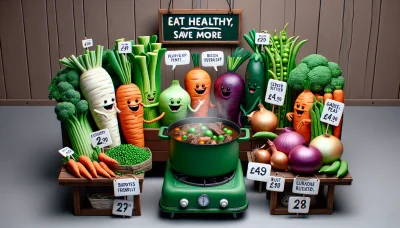Is It Still Pizza Without Cheese or Sauce? Quiz
Test Your Knowledge
Question of
Is It Still Pizza Without Cheese or Sauce?
The concept of pizza, as widely recognized, traditionally encompasses a dough base topped with tomato sauce and cheese, then baked to perfection. These components - the tangy sauce and the melty cheese - are often considered essential to what defines a pizza. They work together to create a harmonious blend of flavors that pizza lovers have come to cherish over the years. The question of whether a pizza can still be called a pizza without these key ingredients challenges the very identity of this beloved dish. It invites a broader discussion about the evolution of pizza and how far we can stretch its definition while still honoring its rich culinary heritage.
The Evolution of Pizza: A Health Perspective
Pizza, a beloved dish worldwide, has undergone significant transformation, particularly from a health perspective. Traditionally known for its rich toppings and calorie-dense crusts, pizza has been reinvented by culinary experts and health enthusiasts alike. This evolution reflects a growing awareness of nutritional needs and a demand for healthier dining options. Today, pizza can be found with whole grain or cauliflower crusts, offering lower carb alternatives. Toppings have also seen a shift, with a greater emphasis on fresh, organic vegetables, lean meats, and even vegan cheese options. This transformation not only caters to a broader audience with dietary restrictions but also introduces a way to enjoy this classic dish with a healthier twist.
Ingredients of a Healthy Pizza
Healthy Toppings
- Spinach
- Broccoli
- Bell peppers
- Mushrooms
- Artichokes
- Grilled chicken
- Pineapple
- Red onion
- Olives
- Arugula
Alternative Bases
- Whole wheat dough
- Cauliflower crust
- Almond flour crust
- Spinach crust
- Zucchini crust
- Chickpea flour crust
The Nutritional Benefits of Cheese and Sauce-Free Pizza
Opting for a cheese and sauce-free pizza might seem unconventional, but it offers a variety of nutritional benefits worth considering. Without the added calories and saturated fats from cheese, and the high sugar content often found in pizza sauce, this pizza variant stands out as a healthier option. The absence of cheese reduces the intake of saturated fats, potentially lowering the risk of heart disease. Similarly, by omitting sauce, one can avoid the extra sugars and sodium it typically contains, which is beneficial for maintaining stable blood sugar levels and healthy blood pressure. Furthermore, focusing on a variety of toppings such as fresh vegetables, lean proteins, and herbs can enhance the pizza's nutritional profile by providing essential vitamins, minerals, and fiber. This approach to pizza not only supports a balanced diet but also encourages a more mindful way of enjoying this popular dish without compromising on health.
How to Make a Delicious Pizza Without Cheese or Sauce
- Preheat your oven to 475°F (245°C).
- Prepare a pizza dough and roll it out onto a pizza stone or baking sheet.
- Brush the dough lightly with olive oil.
- Spread a layer of your favorite pesto across the dough as a base.
- Add a variety of sliced vegetables such as bell peppers, onions, mushrooms, and zucchini.
- Sprinkle a mix of herbs like oregano, basil, and garlic powder over the vegetables.
- For added protein, consider topping with slices of grilled chicken or tofu.
- Garnish with arugula and slices of avocado after baking.
- Bake in the preheated oven for 12-15 minutes or until the crust is golden and crispy.
- Let the pizza cool for a few minutes before slicing and serving.
Real-Life Examples of Healthy Pizzas
| Type | Ingredients | Nutritional Values |
|---|---|---|
| Whole Wheat Veggie Pizza | Whole wheat crust, tomato sauce, mozzarella, spinach, bell peppers, mushrooms, onions | Calories: 250 per slice, Fat: 8g, Protein: 12g, Carbohydrates: 36g |
| Chicken and Avocado Pizza | Thin crust, grilled chicken, avocado, low-fat cheese, tomato, red onion, cilantro | Calories: 270 per slice, Fat: 9g, Protein: 15g, Carbohydrates: 32g |
| Spinach and Feta Pizza | Whole grain crust, spinach, feta cheese, olives, tomatoes, garlic sauce | Calories: 200 per slice, Fat: 6g, Protein: 10g, Carbohydrates: 28g |
| BBQ Chicken Pizza | Whole grain crust, BBQ sauce, chicken breast, red onions, cilantro, low-fat mozzarella | Calories: 220 per slice, Fat: 5g, Protein: 18g, Carbohydrates: 30g |
Conclusion: Redefining Pizza for Health
In summary, redefining pizza to fit a healthier lifestyle is not only possible but also enjoyable. By incorporating whole, nutrient-rich ingredients, choosing healthier toppings, and being mindful of portion sizes, pizza can indeed be a part of a balanced diet. We encourage readers to explore the vast array of healthy pizza options available, experiment with homemade recipes, and discover that health and pizza can go hand in hand. Let's embrace a new perspective on pizza, one slice at a time.












